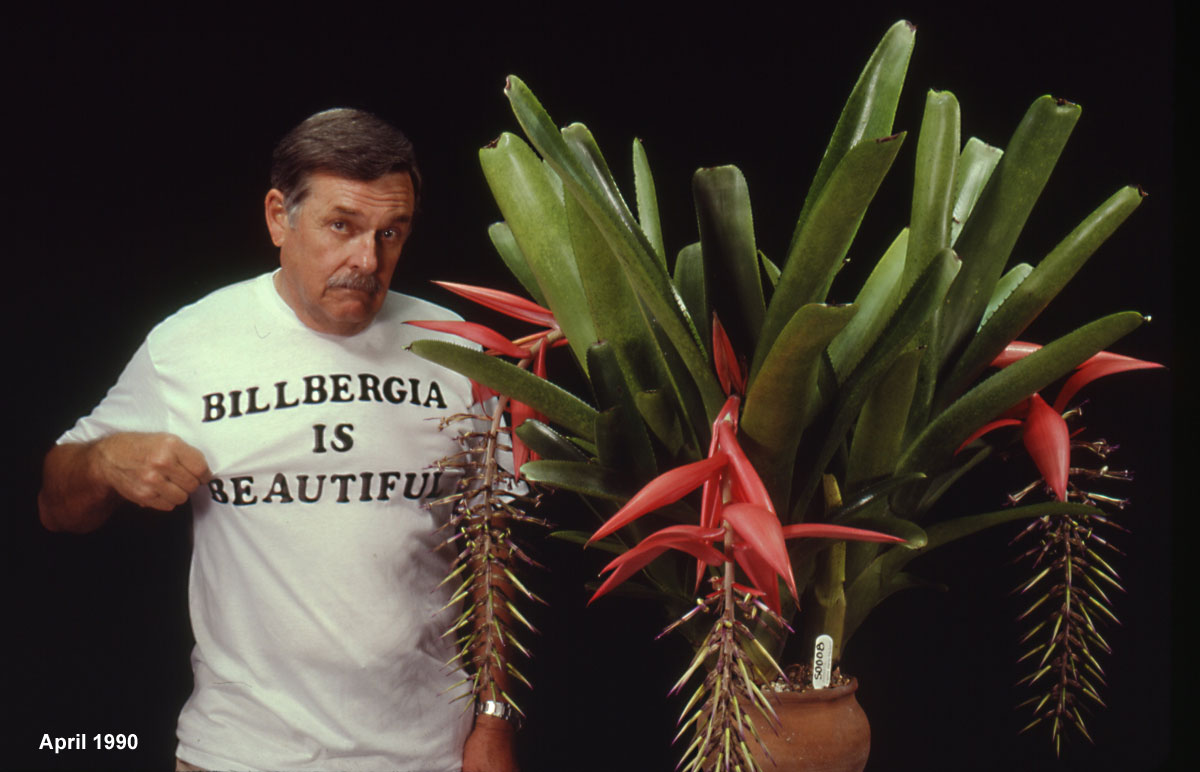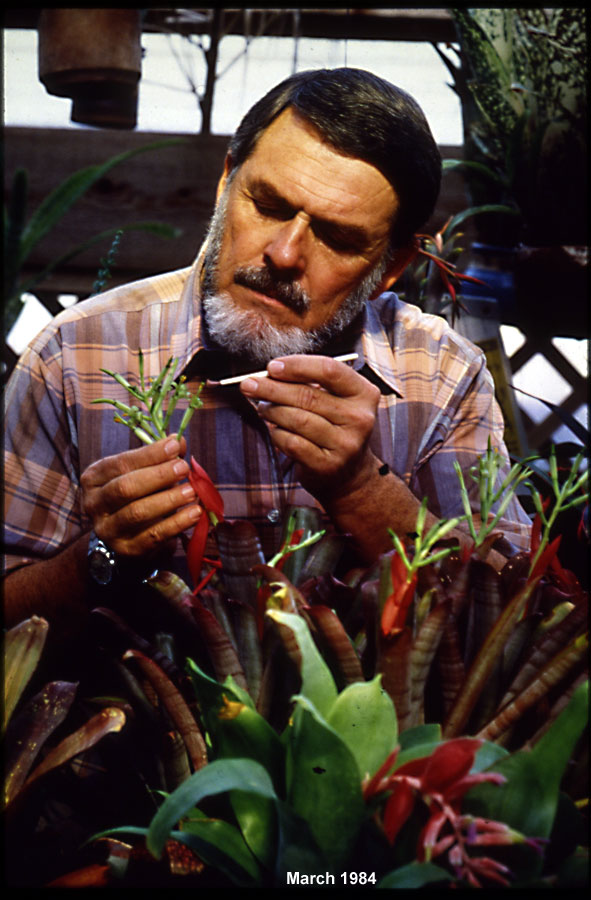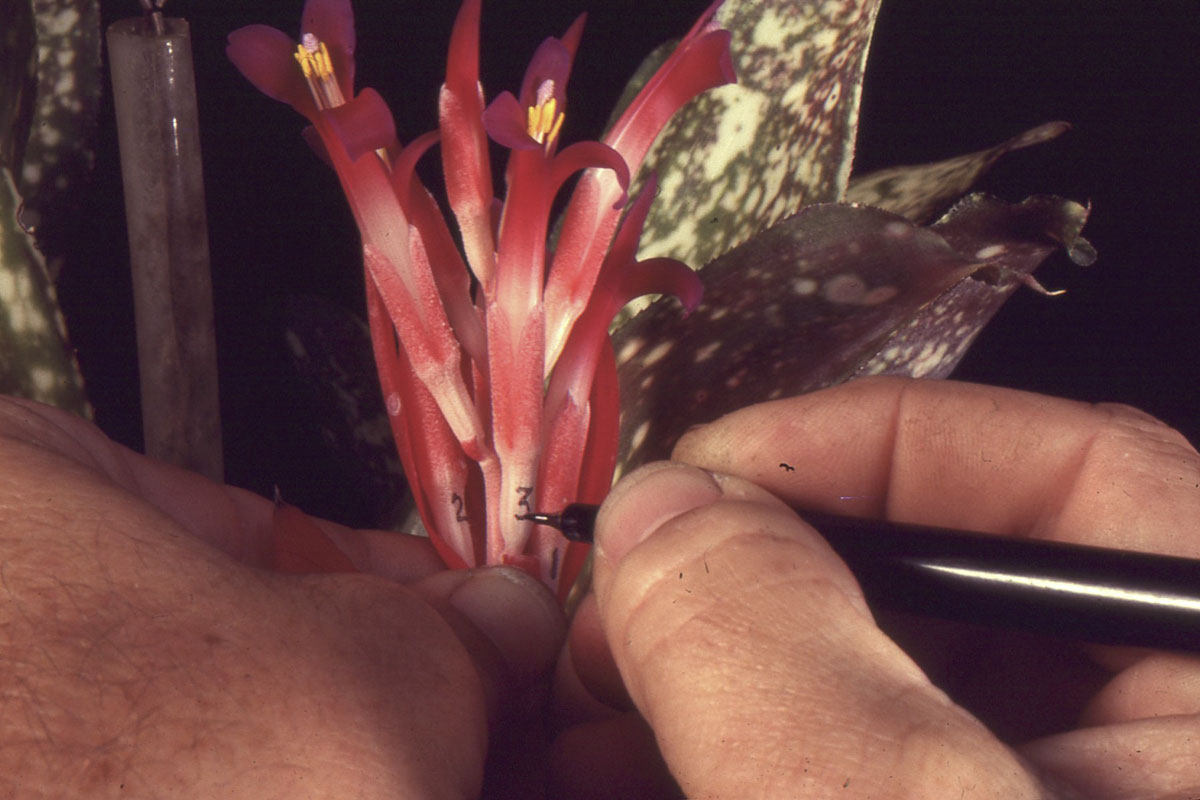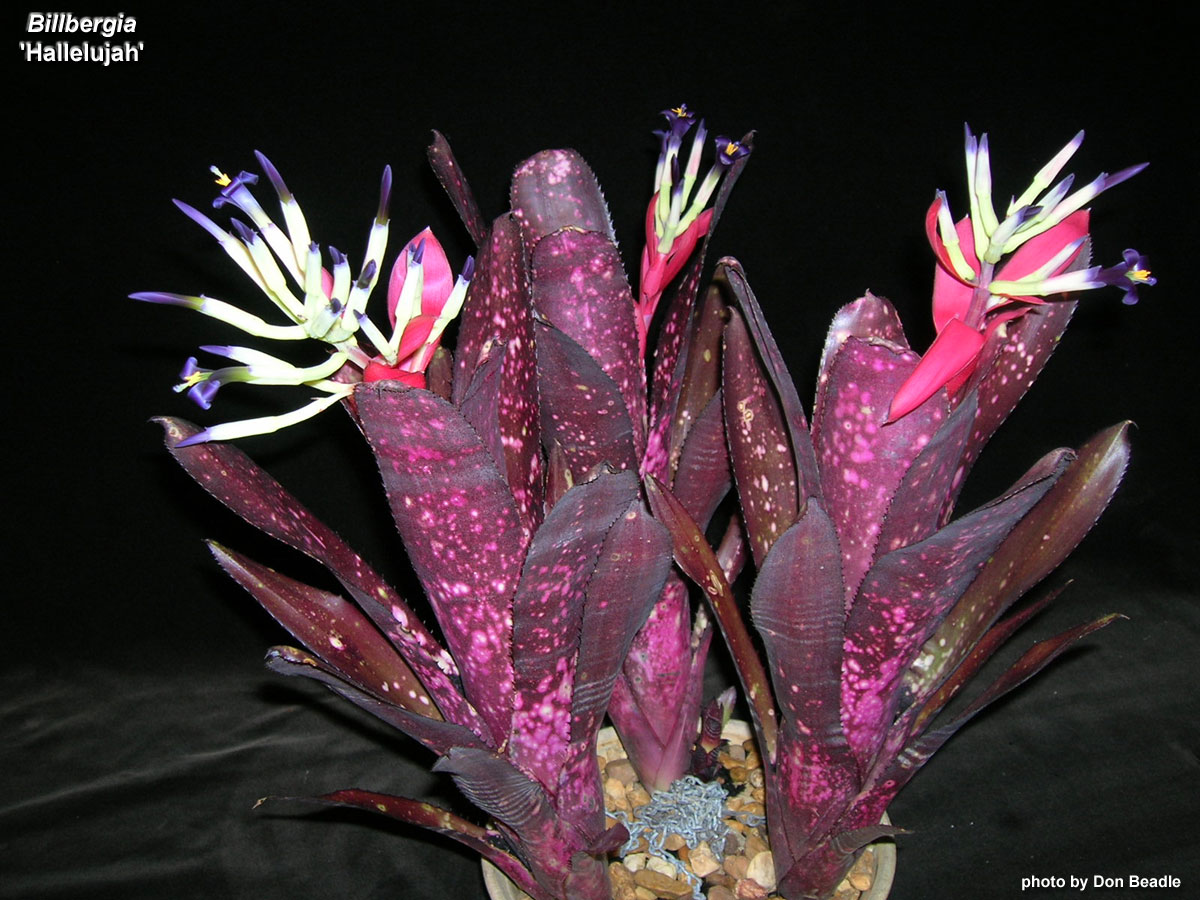

 |
 |
In the beginning, Billbergia was a modest little plant, often plain green with three leaves, a few spots and a quick-lived inflorescence. It was relegated to the back of collections, neglected and disrespected. Then Billbergia met Don Beadle; neither was ever the same again.
Born in Lafayette, Louisiana, Don Beadle never quite fit in. "I couldn't play the banjo and I couldn't talk Cajun," he says, so he booked out of Louisiana at age 19, joining the Air Force. College followed four years of military service, and Don Beadle was now a petroleum engineer. He started with Philips Petroleum and worked his way into smaller and smaller companies until he had his own, Macero Minerals in Corpus Christi, Texas.
Preserving pollen was the first big challenge. After only two or so days, it would turn green and lose viability. Once he figured out that freezing the pollen kept it viable for up to two years, it became "compulsive, an addiction," he remembers.
Don continued to create better, more beautiful, sexier Billbergias to the extent that they soon moved to the forefront of sales and shows. Everyone wanted a Don Beadle Billbergia. Billbergias were no longer the red headed stepchild of the bromeliad world. 'Afterglow' with its rich, deep pink blush does literally glow as light shines through its leaves. 'La Noche's' dark, banded leaves are dramatic and stunning. 'El Capitan' is another dramatic Billbergia whose sturdy leaves have both banding and spots.
So in 1986, Don sold his Corpus Christi house and moved to First Dirt Road in Venice, home to Los Milagros nursery. He fell in love with the place, rebuilding the greenhouses and growing like mad. To date, he has created more than 140 named cultivars and many more yet to be named.
While he continued to hybridize, Don was breaking ground in yet another area: photography. He set up a dedicated space for taking pictures and decided it would be more dramatic and compelling to photograph bromeliads in clumps rather than singly, then the norm. Every day he checked for blooms so he could catch the flowers at their (quick) peak. He experimented with lighting, finally settling on blue photo bulbs for the most honest light. Using a Nikon camera with a full array of lenses, he honed his photographic skills and incorporated double exposures into his photographic repertoire. When Don decided to create a photographic record of species, Harry Luther suggested that Don dissect the flower and capture its qualities in intimate detail. In those pictures, Don started using "that little white ruler that I love I got unadulterated pleasure from the photography. It gave me a lot of satisfaction."
Don's presentations at World Conferences became standing room only events, as those who attended the recent one in Orlando can attest. Audiences sat in rapt silence as Don's slides were shown, with minimal but very often pithy commentary from Don and to the accompaniment of quiet music. His photographs set the standard for both scientific presentation and artistry. His technique and the quality of his legacy are evident today. The next time you see a beautiful picture of a bromeliad, you will catch the echoes of Don's influence.
The legacy does not end there, however. In 1998, Don Beadle compiled the last published Bromeliad Cultivar Registry for the BSI. This monumental work was the bromeliad bible of nomenclature and bloodlines of every known cultivar at the time. Don compiled this tome on a computer - it is hard to imagine now how revolutionary this technology was at the time - yet he understood that it was obsolete in many ways as soon as it was published. Beyond having taken on this labor- and time-intensive task for the bromeliad world, he recognized that changes, new information and new cultivars would overtake the publication within a very short time. He also believed that the Internet would be a way to offer accessible information.
To that end, Don first suggested to the BSI those digital files be made available on compact disk but he was ahead of his time with technology. That was an impractical suggestion as most people at that time did not have access to the kinds of programs that would handle such a document. So Don offered the files to Florida Council of Bromeliad Societies webmaster Michael Andreas. Michael was able to create the format for the Internet and make the living, flexible Cultivar Registry available for world access. Don's work at organizing, educating and providing information about bromeliad cultivars lives on.
In 2000, Don's life took another turn, and he sold Los Milagros, the nursery and the property, to Michael Kiehl who moved his nursery, Michael's Bromeliads, to First Dirt Road. Don now had time to indulge in other passions - tennis, his boat and Joann Buell, his lovely companion of so many years. "She makes all things so worthwhile," Don says of Joann with that twinkle in his eye.
Today, Don can often be found at Michael's Bromeliads. Don has reorganized the Beadle Billbergia collection that lives and thrives there, sharing information and memories with Michael Kiehl. Don's amazing collection of photographs now live on the website of the Florida Council of Bromeliad Societies (fcbs.org) in yet another collaboration with Michael Andreas.
Don's passion for bromeliads led to ground breaking Billbergia cultivars that made this genus one of the most popular; his ground breaking bromeliad photography set the standard for bromeliad pictures; his passion for knowledge led to the Bromeliad Cultivar Registry; his vision for an accurate registry accessible and available to one and all took him beyond his peers and now serves the entire world.
Don Beadle's legacy has had a deep impact on our bromeliad world. We are all the richer for his being our friend and mentor.
 In Corpus Christi, John Anderson and Don were neighbors, sharing coffee and cigarettes every morning before work. Thus began a lifelong friendship that, in later years, made them a popular duo of auctioneers, sought after as much for their stories and banter as their auctioneering skills.
It was during those early days that Don discovered bromeliads. He went to a bromeliad society meeting, and the addiction was immediate. His first bromeliad was Aechmea 'Black Jack'. "You just can't kill this plant," Don says with great fondness. John became a renowned grower of Aechmeas. "John never did anything half-assed," Don remembers.
In Corpus Christi, John Anderson and Don were neighbors, sharing coffee and cigarettes every morning before work. Thus began a lifelong friendship that, in later years, made them a popular duo of auctioneers, sought after as much for their stories and banter as their auctioneering skills.
It was during those early days that Don discovered bromeliads. He went to a bromeliad society meeting, and the addiction was immediate. His first bromeliad was Aechmea 'Black Jack'. "You just can't kill this plant," Don says with great fondness. John became a renowned grower of Aechmeas. "John never did anything half-assed," Don remembers. Don was fascinated by the variety of bromeliads and wanted to collect every one in the world. The impracticality of it soon became apparent, and so he narrowed his focus on the lowly and lonely Billbergia. "I collected all the species I could find - there were about 20 available at the time," he says. He looked for cultivars although they were few and far between. "Mulford Foster had made 'Fantasia' and R. Wilson had made 'Catherine Wilson' but, in general, Billbergias had not really caught on in popularity." Don was fascinated by the idea of making hybrids and found the process exhilarating.
Don was fascinated by the variety of bromeliads and wanted to collect every one in the world. The impracticality of it soon became apparent, and so he narrowed his focus on the lowly and lonely Billbergia. "I collected all the species I could find - there were about 20 available at the time," he says. He looked for cultivars although they were few and far between. "Mulford Foster had made 'Fantasia' and R. Wilson had made 'Catherine Wilson' but, in general, Billbergias had not really caught on in popularity." Don was fascinated by the idea of making hybrids and found the process exhilarating. Still, he was growing green Billbergias. It was a limiting process, until Bob Whitman found 'Domingos Martins', the gorgeously spotted cultivar of vittata. "I lusted after that bromeliad with a passion," Don says. After much coercion and a year's wait, Don got a pup and went to work. He crossed 'Domingos Martins' with 'Ed McWilliams', and Billbergia 'Hallelujah' was born. Prized for its rich deep red leaves and its white and pink spots, its foliage appeal long outlasts its stunning magenta scapes and purple flowers. 'Domingos Martins' revolutionized hybridizing and today is found in many Billbergia cultivars.
Still, he was growing green Billbergias. It was a limiting process, until Bob Whitman found 'Domingos Martins', the gorgeously spotted cultivar of vittata. "I lusted after that bromeliad with a passion," Don says. After much coercion and a year's wait, Don got a pup and went to work. He crossed 'Domingos Martins' with 'Ed McWilliams', and Billbergia 'Hallelujah' was born. Prized for its rich deep red leaves and its white and pink spots, its foliage appeal long outlasts its stunning magenta scapes and purple flowers. 'Domingos Martins' revolutionized hybridizing and today is found in many Billbergia cultivars. Don quickly ran out of plant growing space and built his first greenhouse. More hybridizing soon followed, as did a larger house and a larger greenhouse, where he lived and grew bromeliads for ten years. He came to Florida to visit Harry Luther and Wally Berg, who, as it turned out, were off in South America on a collecting expedition. Through happenstance, he ended up at a realtor's and told the agent he wanted a "house on the beach with room for some greenhouses." The agent later called him with news of a place with a fresh water pond and three greenhouses full of dead plants; Don made the deal over the phone.
Don quickly ran out of plant growing space and built his first greenhouse. More hybridizing soon followed, as did a larger house and a larger greenhouse, where he lived and grew bromeliads for ten years. He came to Florida to visit Harry Luther and Wally Berg, who, as it turned out, were off in South America on a collecting expedition. Through happenstance, he ended up at a realtor's and told the agent he wanted a "house on the beach with room for some greenhouses." The agent later called him with news of a place with a fresh water pond and three greenhouses full of dead plants; Don made the deal over the phone.















Bromeliad Drawings, Art and Notes
©Copyright Notice: All photos are copyrighted © and may only be used by permission. COMMERCIAL USE OF THESE PHOTOS IS STRICTLY PROHIBITED.